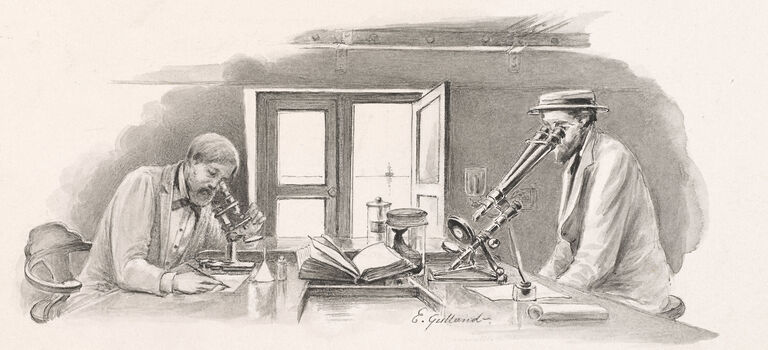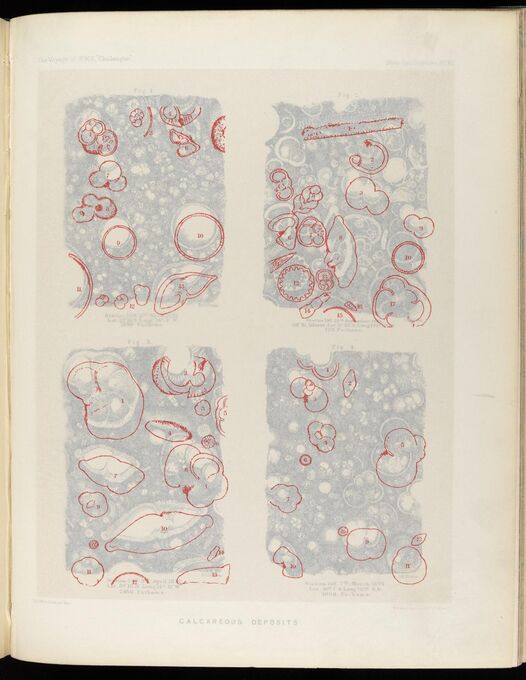Making the deep sea visible
the Challenger Report

Challenger played an essential physical role in retrieving data and specimens from the world’s oceans, but also as an intellectual space for scientific deliberation, testing and writing, and the process of publication.
Although scientific staff published their preliminary results during the voyage, at the heart of the publishing project was the Challenger Office in Edinburgh which coordinated the movement of specimens, images, and text with collaborators around the globe.
Transferring the scientific work from sea to land, Thomson had the Challenger collection of over 100,000 specimens moved to 32 Queen Street in New Town. In a time when individuals and nations competed for the prestige of scientific discovery and the control of maritime and government resources, Thomson used this space to foster a network of marine zoologists from Europe and America.
It would take the dedicated work of specialists to categorise, select, name, and describe new species and prepare reports for publication. But before specimens could be distributed, the collection had to be catalogued and prepared for travel.
To help with sorting the collection, Thomson called upon his colleagues in the international scientific community who travelled to Edinburgh to observe and discuss what specimens, data, and materials had been discovered.
|
||||
| Object reference | NLS Signet.s.088 | |||
|---|---|---|---|---|
| Credit / Usage information | Image courtesy of National Library of Scotland (CC-BY-NC-SA Signet) |

Historians and scientists consider the 50 volumes that make up the Report on the Scientific Results of the Voyage of HMS Challenger During the years 1872-76as the intellectual foundation of oceanography. This series included 30,000 pages of letterpress, 3,000 lithographic plates, 200 maps, and numerous woodcuts. Hundreds of people, including sailors, artists, illustrators, printers, editors, naturalists, analysts, chemists, and many more, contributed to and shaped the reports’ construction.
With the publication of the final volume in 1895, the report presented a compendium of what was known of the oceans at the end of the 19th century, contributing to a baseline for how we measure the effects of climate change on our oceans today.
One of the most significant volumes of the series is the Report on the deep-sea deposits based on the specimens collected during the voyage of HMS Challenger in the years 1872 to 1876 which transformed the study and scientific understanding of the geology of the ocean floor. This chart, which appears in the report, was the first to show global distribution of deep-sea sediments.
|
Understanding and illustrating the ocean floor
While most of the volumes of the Challenger Report were dedicated to marine zoology, reports on the physical and chemical aspects of the ocean added vital strands to the development of ocean science. Over a period of ten years, John Murray and Belgian geologist Alphonse Renard (1842-1903), co-authors of the Report on Deep-Sea Deposits, carried out an extensive analysis of the rocks and sediments that the expedition had dredged and sounded from the ocean floor.
In a radical change to how we study and illustrate the composition of geologic materials, the report introduced for the first time the techniques of microscopic petrography to the study of ocean sediments. This new method of geologic analysis developed in the 1860s and 1870s, in which thin slices of rock were viewed under powerful microscopes, could determine the history and composition of ocean sediments.
Using this technique and others, the Report on Deep-Sea Deposits explained the origin of red clay found at great depths, analysed the composition of manganese nodules, and discovered extra-terrestrial materials in deep-sea sediments.
Click the images below to discover more about these techniques.

In the Report on Deep-Sea Deposits Murray and Renard also added new features to existing illustration techniques. Putting thin sections of deep-sea deposits under the microscope revealed the shells of a range of foraminifera, single-celled organisms about the size of a grain of sand. This printed tissue overlay outlined and labelled different species, helping readers to better identify these small fossils in the rock.
Challenger collected foraminifera both as live specimens from tow nets and as fossils found in deep-sea dredgings. These tiny organisms are integral to balancing the carbon cycle, building their shells from calcium carbonate. When they die, they sink, bringing carbon down to the ocean floor which helps neutralize acidity.
Foraminifera are sentinels of climate change. Comparing specimens collected in the 21st century to those collected by Challenger, reveals they have significantly thinner shells. Increased carbon in the atmosphere has increased ocean acidity, conditions which make it difficult for shell building. With thinner shells less carbon is locked in the oceans when they die and sink to the floor. This negative feedback loop leaves more carbon in the air, which, in turn, increases ocean acidity.
|



